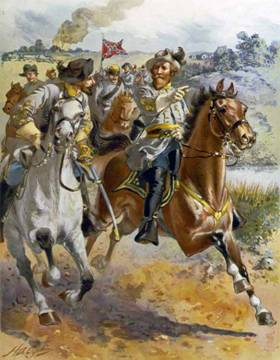From the outbreak of the Civil War until July 1863 General Robert E Lee, commander of the rebel Confederate forces was able to repulse, evade, and defeat a much superior size and equipped army of the Potomac. He relied on precise, accurate information about the movement of his adversary as provided for him by his cavalry commander Jeb Stuart.  This flamboyant, attention seeking, audacious, Major General provided reliable information that allowed Lee to at one point to divide his inferior forces and capture an important victory at the battle of Chancellorsville. That confidence building victory propelled Lee to invade the North in June of 1863 bent on dealing the Union a crippling blow that would capture Washington DC and bring Great Britain to the Confederate forces aid.
This flamboyant, attention seeking, audacious, Major General provided reliable information that allowed Lee to at one point to divide his inferior forces and capture an important victory at the battle of Chancellorsville. That confidence building victory propelled Lee to invade the North in June of 1863 bent on dealing the Union a crippling blow that would capture Washington DC and bring Great Britain to the Confederate forces aid.
Stuart’s cavalier efforts to bring personal fame and fortune to himself and his cavalry eventually led to Lee’s ill informed decision to attack a superior force (almost double his size 150,000 to 90,000) in a dominate defensive position at Gettysburg. Arguably had Stuart been more accountable for his role of supplying troop size and movement information to the Confederate Army Lee might have accepted General Longstreet’s advice to flank the Union positions at Gettysburg and advance on to Washington rather than commit his forces to Gettysburg. The rest as they say is history.
Today your leadership team needs to have information that serves the same purpose that Jeb Stuart’s cavalry provided General Lee. This is the value of Leading Indicators.
In Are There Three or Four Disciplines to Execution, authors by Chris McChesney, Sean Covey, Jim Huling, The 4 Disciplines of Execution: Achieving Your Wildly Important Goals expand upon Positioning Systems Strategic Discipline’s definition of metrics into two additional elements, lead indicators and scorecards. The distinction of developing leading indicators emphasizes the critical value to forecast events and influence them.
Let me provide a reminder of the author’s definition of a lead indicator: Lead measures are different; they foretell the result. They have two primary characteristics. First, a lead measure is predictive, meaning that if the lead measure changes, you can predict that the lag measure also will change. Second, a lead measure is influenceable; it can be directly influenced by the team. That is, the team can make a lead measure happen without a significant dependence on another team.
At a sales training meeting yesterday one of the participants indicated he was booking sales training for his RV software programs for mid-march of 2013. This is a good example of a leading indicator. What do you suppose this offers the owners of this company to do in terms of forecasting and decision making? If you know you have your first quarter already solidly booked and your revenue targets achieved doesn’t this provide confidence for forecasting the remainder of the year and planning your resources through the first quarter? This is the value of a lead indicator, in this case a sales pipeline indicator.
Developing leading indicators is a challenging yet not overly demanding project. Often times the difficulty is simply discovering how important they are to help you make decisions. Get your leadership team together to conduct collective intelligence on the value of leading indicators and discuss what these might be for your company and your industry. You’ll like receive excellent feedback and see results quickly. You may wish to include your tactical level people who are often more aware of the contributing factors that influence and predict the nature of the outcomes they produce. An example of a leading indicator to determine why defects increase in the manufacture of automobiles is employee absenteeism. Quality significantly decreased due to employee’s being absent.
What forecasts quality in your business. What predicts your sales revenue and perhaps the satisfaction of your employees and customers? One of my clients could predict profitability at his car wash locations by the increase in his customer satisfaction level as indicated by his Net Promoter Score.
If you are challenged by this process contact Positioning Systems or a Gazelles business coach for help. That leads me to the discussion for our next blog the final element of Gazelle’s 4-3-2-1 formula – Catalyst. Join me on Monday as we discuss what a catalyst is and how they can help you to grow your business.






.jpeg?width=150&height=135&name=Hand%20with%20marker%20writing%20the%20question%20Whats%20Next_%20(1).jpeg)

